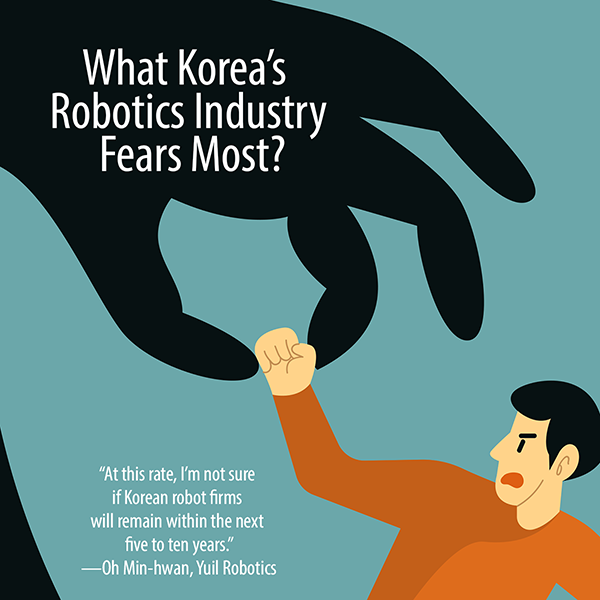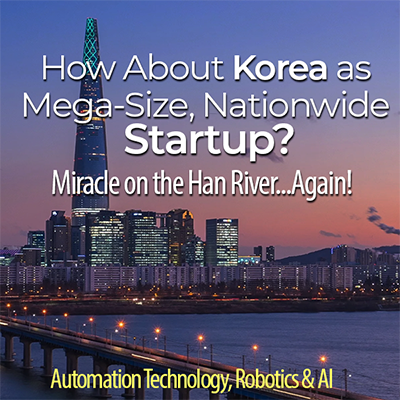Looming Crisis
What Korea’s
Robotics Industry
Fears Most

“At this rate, I’m not sure if Korean robot firms will remain within the next five to ten years.”
—Oh Min-hwan, director at Yuil Robotics
So, just exactly what are Korea’s fears?
How about a looming crisis in robotics?
The rapid rise of Chinese and Japanese competitors, armed with aggressive pricing strategies and advanced manufacturing capabilities, has left Korean firms struggling to maintain their foothold in both domestic and global markets. Industry leaders warn that without immediate intervention, Korea’s robotics sector could be pushed to the brink of collapse within the next decade.
Korean robotics firms are being squeezed from two directions: high-end Japanese robots produced at lower costs in China and ultra-cheap Chinese-made alternatives. Chinese manufacturers, backed by state subsidies and a vast domestic market, have slashed prices to levels Korean firms cannot match. Meanwhile, Japanese giants like FANUC and Yaskawa have moved production to China, allowing them to undercut Korean prices by 30-40%.
In 2024, China accounted for 80.5% of Korea’s industrial robot imports, up from just 27.3% in 2018. This flood of low-cost robots has forced Korean firms like Hyundai Robotics and Yuil Robotics to file anti-dumping complaints, but many fear it may be too late to reverse the trend.
2025 reprise of The Miracle on the Han River
Theodore Roosevelt famously said, “Nothing worth having comes easy”. Korea, more than many other nations, understands that as part of its national character.
Korea has faced looming crises and disaster scenarios before and prevailed, but not without some wrenching agony. In fact, modern Korea was born from the disaster of 38 years of occupation and a Second World War that didn’t end for Korea until 1955. Even as late as 1960, Korea was poorer than countries in sub-Saharan Africa.
Korea in 1961 was in sorry condition. “Korea was by all standards a failed state after the Korean War (1950-53). GDP per capita in South Korea in early 1960’s was below $100. Lower than Haiti, Ethiopia or Yemen, making South Korea one of the poorest countries in the world.
Korea needed something, and that something came in the form of Park Chung-Hee, and his first Five-Year Plan called “The Big Push”.
That was the impetus to Korea’s rise as an industrial and technology powerhouse. A spectacular feat that is today loosely referred to as The Miracle on the Han River.
Okay, so there’s overwhelming price competition from China and Japan. What else?
How about loss of market share in core industries
Korea’s robotics sector has stagnated at $3.5 billion in annual sales since 2017, while China and Japan continue expanding. Even Korean automakers—traditionally loyal to domestic suppliers—are increasingly turning to foreign robots. For example, a major Korean car manufacturer recently chose FANUC and China-owned KUKA over local suppliers due to cost advantages.
Then too, how about falling behind in next-gen robotics (AI & humanoids)?
While Korea excels in industrial robotics, it lags in AI-integrated robots and humanoids, which are expected to dominate future markets. Chinese firms like Unitree Robotics already sell humanoids for $16,000, far below global competitors. Meanwhile, U.S. companies (Tesla, Boston Dynamics) lead in advanced AI robotics, leaving Korea with only Rainbow Robotics as a notable player in humanoids.
Then there’s, worse news still. China’s rapid advancements in Generative AI (GenAI)—holding 70% of global patents—mean that Chinese robots will soon combine cheap prices with AI-driven intelligence, making them even more formidable.
Three potential outcomes if fears are realized
- Collapse of domestic robot manufacturers
If price wars intensify, small and medium-sized Korean robotics firms (98% of the industry) could disappear, leaving only a few conglomerate-backed players. This would mirror Korea’s past struggles in industries like shipbuilding and displays, where Chinese competition led to massive consolidation.
- Dependence on foreign robotics technology
Korea risks losing control over its smart factories and automation infrastructure, forcing reliance on Chinese and Japanese suppliers. This could weaken national security, particularly in defense and semiconductor manufacturing, where robotics play a critical role.
- Missing the “AI Robotics” revolution
If Korea fails to invest in AI-driven robotics, it could be locked out of the next industrial wave. Humanoids and autonomous service robots are expected to revolutionize manufacturing, logistics, and healthcare—sectors where Korea aims to be a leader.
See related: Hyundai Expands Korea’s Grand Robotics Plan
Korea’s countermeasures: short-term (2025) and long-term (2030) plans
- Boosting local production of core components (short-term)
Korea currently imports 56% of critical robot parts (e.g., servomotors, reducers). The government’s Fourth Intelligent Robot Basic Plan (2024-2028) aims to increase local manufacturing rates to 80% by 2030 through $2.24 billion in public-private investments.
- Strengthening AI and humanoid development (long-term)
To compete with China and the U.S., Korea is:
- Expanding R&D in AI-integrated robotics (e.g., combining machine vision with industrial robots).
- Investing in humanoid robotics, particularly for smart factories and healthcare.
- Encouraging partnerships between hardware and software firms to create fully integrated robotic solutions.
- Regulatory and financial support for SMEs (short & long-term)
- Anti-dumping measures against unfairly priced Chinese and Japanese robots.
- Tax incentives and subsidies for domestic robot adoption in manufacturing.
- Vocational training programs to upskill workers in robotics maintenance and AI.
Conclusion: a race against time
Korea’s robotics industry stands at a crossroads. While it remains a leader in robot adoption density (1,102 robots per 10,000 workers), its production capabilities are under siege. The threat from China and Japan is not just about price—it’s about technological dominance in AI and next-gen robotics.
If Korea fails to act decisively, it risks losing its robotics industry entirely. However, with strategic investments in AI, local component production, and SME support, it can still reclaim its position as a global robotics powerhouse. The next five years (2025-2030) will be critical in determining whether Korea’s robotics sector survives—or gets left behind.
Key Takeaways
Biggest fear: Being outcompeted by cheap Chinese robots and AI-driven automation.
Realistic risks: Market collapse, foreign dependency, missing the AI robotics wave.
Korea’s plan: Increase local parts production, invest in AI/humanoids, protect SMEs.
This is sizing up to be an epic battle for high-tech survival, which, of course, would be very much akin to Miracle at the Han River.


